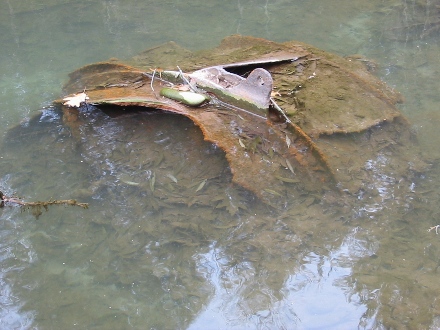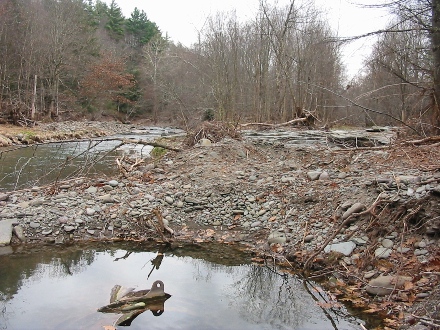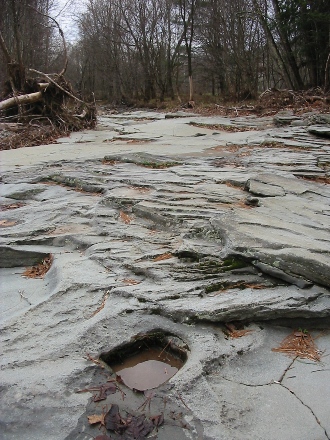The waters were cruel in our region late last summer. They claimed buildings, land and one precious life, and left a legacy of ruin that will take months, even years, to repair. But the flood also uncovered a bit of the past in a section of Dry Brook on the property of Gene Rosa.

Submerged water wheel that once ran a Dry Brook sawmillChiseled hole in old streambed for post of sawmill
The rusty remnant of an old water wheel bears mute testimony to the many mills that once thrived along Dry Brook, as well as to the power of the tempestuous creek that regularly destroyed them. Lester Rosa remembers hearing about this one. It powered a sawmill on his grandfather William Vermilyea’s farm (on the sharp curve 3.5 miles up Dry Brook Road from Arkville), where there was also a blacksmith shop and forge on the flat. Lester, who dug up artifacts from the blacksmith shop while gardening on the site over the years, speculates that the water wheel may have been made at that forge.

Water wheel jutting out of pool in foreground; former streambed to right
Lester’s paternal grandfather, Andrew Rosa, who died in 1915, was a sawyer who worked at this and other mills. It’s not clear whether it was abandoned before or after being washed off its moorings by some flood in the past.
It was one of no less than five sawmills that are depicted on the Beers map of 1869 on the Middletown end of Dry Brook – no doubt many more took advantage of the water power further up the stream in the Town of Hardenburgh. In 1869, this site belonged to Orson Allaben, a physician who helped develop Margaretville, served in the NYS Assembly and started a school. He also apparently dabbled in small industry. An article in the Nov. 26, 1948 Catskill Mountain News about the history of Arena (Lumberville) said this: “As in the case of (Asa) Grant, many of the wealthy men owned sawmills in connection with their other interests. One of them was Dr. Allaben of Margaretville, who owned several such mills in the various hollows of the section.”
Lester Rosa said deeds to his grandfather’s farm referred to it as the “Allaben Logging Reserve.”
Can you add information to this story? Write to us!

Chiseled hole in streambed for post of mill building
